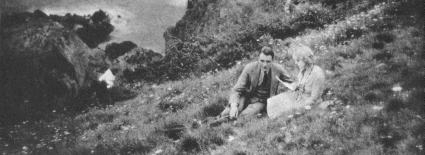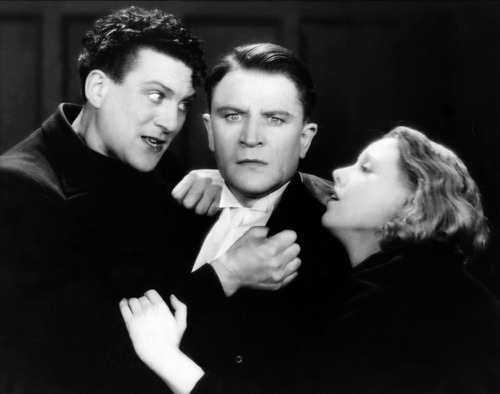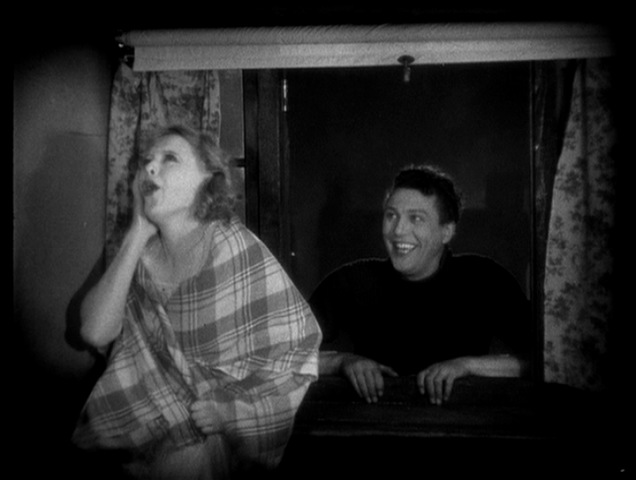|
|
The Manxman
lands on its feet
article for Hitchcock
Magazine
I have always thought
it sad that so much has been written on the Hitchcock oeuvre, with no
one paying much attention to the silents in
general, and ignoring The Manxman [1929] in particular. Alfred
Hitchcock himself made a few remarks in passing about it, in the Truffaut interview, only one of which is notable, and
which will be discussed. But I am not sure that anyone has actually seen
and criticized this film with the enthusiasm devoted to a work on the order
of Vertigo or Psycho. I do not exaggerate
when I say that this is an important film, which is necessary to
intelligently view to understand some of what was to follow in Hitch's
career. The Manxman is a microcosm of his later camera and story
technique, which says to me that if the picture had
been more successful in its first run, its director might well have made
thrillers only occasionally, and more dramatic pieces as a matter of course.
For while The Manxman is not a thriller by any means, it is a gem of a
film, a study in character, and the manner in which the camera reveals the
characters to the audience. Its first half, at any rate, is top drawer silent
cinema, and is every bit as good as any Hitchcock up until, say, the first
Man Who Knew Too Much, because it seldom relies on formula, but invents
as it goes along, and more importantly, the audience understands and follows.
This to me is the trademark of a ground breaking director, as opposed to
those whose films are so obscure in technique (say, Man With a Movie
Camera) that they are alienating to an audience, or loaded with hommage (almost the entire œuvre
of Brian DePalma) that they seem like clones of one
another. For those unacquainted
with his silent films, Hitchcock began his career writing the dialogue intertitles or subtitles, as they were called then (the
Main Title being the distinction making all other word titles
"sub-") and he eventually directed a film in Admittedly, The
Lodger is so mawkish at times, one needs to
watch it with one of those sly "the old days" asides to enjoy it.
Not so much of that is needed in The Manxman. In fact, it takes little
effort to cast aside the Grand Manner acting techniques which make so many
audiences laugh today, and really enjoy the picture as it was meant to be
enjoyed. Many critics, after
noting that The Lodger foreshadows the master's future efforts at
thriller pictures, buzz through the silents and
land with a perceptible thud upon Blackmail in 1930, where they have
the choice of calling it a silent or a sound film. One reason for this bum's
rush to the talkies is surely the sheer difficulty in obtaining prints,
either on video or in any format of film, to view them. Secondly, the prints
which are available suffer from the usual lack of attention to silent
films: wrong projection speed, mis-placed titles,
scenes out of order, amateurish scores—if any at all—asking the viewer to
further compensate in viewing. The actual
presentation method from 1929 is almost impossible today. It really is too
much to ask to project a 35mm print, at the proper speed, in correct aspect
ratio, with a live or carefully planned recorded score in synch with the
picture, in front of a large audience. When it has been done, the effect is
electrifying: witness the glorious presentation of Abel Gance's
Napoléon at Of course, even in the
most careful reconstruction of print and presentation, the only impossible
element impeding full enjoyment is to be seated among an audience of 1929.
They will know when to laugh and when to cry, and do not roll their eyes as
easily as we. After all, film directors were directing for them, and
any criticism of their films now has to take that long gone audience into
account. II Granted that today we
can see say 25% of the ideal, Hitchcock's The Manxman unreels with a
title sequence of the sea crashing on the shore, then a haunting shot of
fishing boats heading in from the sea, back to the
A three-legged symbol, a triskelion or triskele (both from the Greek, τρισκέλιον or τρισκελής, for "three-legged") also Manx, is on a sail in a soft-focus closeup, and it sails
off to the left as the other boats emerge. (The symbol’s motto, “Quocunque Jeceris Stabit” means ‘toss it any way, it will land on its feet.’)
These two initial symbols practically telegraph the rest of the film: a
battering by overpowering natural forces, and a binding of three limbs into
one. These are developed like musical themes, again and again.
We soon meet a
fisherman, Pete, who is an enthusiastic young man, and who has a most
enthusiastic face. Pete's face is rather like a barometer in this film, and
the audience can read it immediately. He enters port, and is met by his
boyhood friend, Phil, who is a lawyer. Phil almost
immediately spirits Pete away to the local pub, where the two men are engaged
in persuading the townspeople to sign a petition about fishing rights, which
Phil declares he'll "take to the Governor, if necessary." The
relationship between the two is written on their faces: open, enthusiastic,
cheerful, and in Pete's case, wide-eyed and innocent. They sign the paper;
Phil fluently, Pete laboriously. Handwriting is a minor element to be paid
attention to in this film, as so much is conveyed by it. Indeed, there are
times when the intertitle does its job of
announcing dialogue, and others when speech is
implied or conveyed in other manners. In Hitch's long interview, Truffaut observes that he "dispenses with a
title" at a critical moment in the film, and Hitchcock agreed. But
communication to the audience by implied lip-reading is one of several
methods used in the film, and needs to be observed very carefully.
The triangle here, so foreshadowed by the
three-legged Manx symbol, is not an ordinary one. The viewer is asked
—coerced perhaps, to participate in Kate's divided attention. Hoqwever,
the title is The Manxman, not The Manxmen. There
is no reason to think that the story favors Phil over Pete for the eponymous
title. And yet the symbol says to us that no matter which way it's thrown, the tri-footed will always land on its feet.
And more importantly, Kate has a father.
We have seen him lurking in the background, behind his partition, of which we'll learn later. He is a dour old gentleman, with a small sailor-like hoop earring in each
ear, and a mind bent on money, money, money. Surely Pete is not going to
succeed in wooing him. Once the pub crowd is gone, a Cyrano-like scene
is played out, where Pete announces to Phil that he wants to ask Kate's
father for her hand. Again, on the character's faces, we read how suddenly
frightened this irrepressible lad is, and how crushed is Phil, who obviously
loves Kate as well, and must decide whether to fulfill his friend's request
and speak to Kate's father about Pete, or try for her himself.
Although less than 10
minutes into the picture, we are presented with a dilemma of
tremendous import. If Phil decides to play Cyrano and intercede for Pete,
he's betraying himself and his happiness, but preserving the love of his
friend. If he further alienates Kate's father purposefully against Pete, he
will obviously be betraying him.
Phil moves to the back
room, where we see him through a large paned partition. It is a scene which
recalls the little silent vignette in The 39 Steps in which Peggy
Ashcroft and Robert Donat are seen talking, the
import of which is thoroughly misunderstood by the Crofter watching them
outside through the window. Yet in The Manxman, it is not simply a
foreshadowing. Throughout this film, a natural frame is used to further pare
down the screen-shape to focus attention on the action. Earlier, Kate in her
light colored dress is glimpsed through a sea of people wearing dark sailor
outfits, through which she looks luminous. This natural framing technique,
whether deliberate or instinctive by directors is a device used significantly
by such directors as Griffith and Eisenstein, who was never happy with the
shape of the cinema screen. It was a technique admirably used by Buster Keaton, especially in Battling Butler, where these
"natural irises" occur at important junctures in the story. The
technique occurs in other silents as well, probably
going back to
Such is the scene
behind the glass-paned partition. We do not see intertitles
as Phil speaks to Kate's father. Amusingly enough, this is an example of
silence in a silent picture, as Pete can't hear what he's saying, but reads
his body language. Were I scoring this scene, I'd have a minimum of music;
perhaps played out really in silence. Clearly Phil is not comfortable talking to the father (and we see the mother listening, sewing in the furthest background), and clearly Kate has begun to prefer Pete, as she coyly goes upstairs, making sheep's-eyes at him, and he waits in agony at the bar for her father's response.
But Kate's papa is not one
to suffer fools. He bursts out of the back room and directly tells Pete to
get out. If he was to consider marrying his daughter, he'd have to have more
money than that.
It's a melodramatic
ploy, and can't be considered much more than that, but the
fugal interplay between the images, with Pete's face, the lighthouse
light rhythmically flashing, and the father's angry looks all seem to earn
the suspension of disbelief. Another Cyrano-like scene occurs, wherein Pete
practically attacks his lifelong friend Phil outside the pub, determined that
he'll go away and make a life for himself. And again, Cyrano-like, the two men are below and she above, coyly turning aside, putting on a shawl and pulling down her decollete at the same time (she is merciless!) Pete appears in her window -- but how? A cut reveals that he is standing on the shoulders of the rather sheepish-looking lawyer, below. As she continues to tie her nightgown's bows and draw her shawl around her, she looks over Pete's shoulder at Phil, and jumps into the casement to make it a cozy trio. "I'm going to foreign lands to make my fortune," a title from Pete announces. And then we see a closeup of Kate, clearly saying with no intertitle, "Oh are you now? Well!" It is extraordinary that this film relies so heavily on lip reading, with very few intertitles at all. They kiss--for the barest second, before Kate pulls down the curtain on him. In a remarkable sequence of shots and reversals, this window becomes a kind of commedia dell'arte proscenium through which we see Kate in silhouette and framed by the panes, manically.
Hitchcock and Anny Ondra in the Sound Test for "Blackmail" (1929)
|
|
© 1999, 2012 John C. Mucci - email:
.
All rights reserved.




